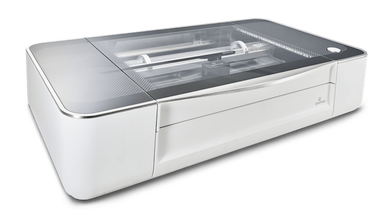GlowforgeThe Glowforge is an easy to use laser cutter and engraver created by the company Glowforge. It uses a class 1 laser to cut through and engrave on wood, acrylic, leather and other materials. Some materials are not safe for the Glowforge to cut or engrave. These include materials with a toxic chemical makeup. Materials that have reflective qualities can redirect the laser and cause damage to the Glowforge. Check the Material Safety section below to learn more.
Machine Specs File Types: SVG and PNG Cut Area: 19" L x 11" W x less than 0.5" H Engrave Area: 18.5" L x 10.5" W x less than 2" H The maximum depth that can be cut or engraved while the crumb tray is in is under 0.5". The maximum depth for engraving while the crumb tray is removed is under 2". Cutting is not available when the crumb tray is removed. The removal of the crumb tray is decided by the size of the material. |
Material Safety
Plywood
Plywood is sometimes made from materials that release irritating, toxic, or corrosive fumes during printing that could harm you or your Glowforge. These include the glue which binds the wood together, the chemicals added to provide weather resistance, and surface finishes to improve the plywood’s appearance. In addition, some plywood is prone to catching fire, which could be hazardous to you, your Glowforge, or your surroundings.
Hardwoods
Hardwoods are sometimes coated with stains or finishes that can release toxic or corrosive fumes during printing that could harm you or your Glowforge. Some species of hardwoods can create fumes or dust that is irritating or triggers allergic reactions. Some hardwood is prone to catching fire, which could be hazardous to you, your Glowforge, or your surroundings.
Plastics
Some plastics like acrylic and acetal are laser-compatible; many more, like vinyl, PVC, ABS, and HDPE can melt or release toxic or corrosive fumes that could harm you or your Glowforge. It can be difficult to tell the difference between types of plastics. Even with laser-compatible plastics, some sizes are susceptible to particularly hot, intense, and long-lasting fires, which could be hazardous to you, your Glowforge, or your surroundings.
Leather
Leather is sometimes prepared with toxic heavy metals that can be released in the air during the printing process that could harm you or your Glowforge.
Cardboard/Paper
Cardboard and paper are extremely prone to catching on fire. They are sometimes prepared with inks or protective chemicals that can release toxic or corrosive fumes during printing that could harm you or your Glowforge. They may have metal staples or fasteners that can redirect the laser beam, causing damage to your Glowforge.
Fabric
Fabric is sometimes made from materials or made with dyes and inks that can release toxic or corrosive gasses during printing that could harm you or your Glowforge. Some fabrics are extremely flammable, which could be hazardous to you, your Glowforge, or your surroundings.
Other
There is no simple and accurate way to tell if a material is laser compatible without the advice of an expert. Many materials are laser compatible, but many more are not. The differences may not be obvious or intuitive. It’s your responsibility to verify that any material you use will be safe for you and your Glowforge.
Plywood is sometimes made from materials that release irritating, toxic, or corrosive fumes during printing that could harm you or your Glowforge. These include the glue which binds the wood together, the chemicals added to provide weather resistance, and surface finishes to improve the plywood’s appearance. In addition, some plywood is prone to catching fire, which could be hazardous to you, your Glowforge, or your surroundings.
Hardwoods
Hardwoods are sometimes coated with stains or finishes that can release toxic or corrosive fumes during printing that could harm you or your Glowforge. Some species of hardwoods can create fumes or dust that is irritating or triggers allergic reactions. Some hardwood is prone to catching fire, which could be hazardous to you, your Glowforge, or your surroundings.
Plastics
Some plastics like acrylic and acetal are laser-compatible; many more, like vinyl, PVC, ABS, and HDPE can melt or release toxic or corrosive fumes that could harm you or your Glowforge. It can be difficult to tell the difference between types of plastics. Even with laser-compatible plastics, some sizes are susceptible to particularly hot, intense, and long-lasting fires, which could be hazardous to you, your Glowforge, or your surroundings.
Leather
Leather is sometimes prepared with toxic heavy metals that can be released in the air during the printing process that could harm you or your Glowforge.
Cardboard/Paper
Cardboard and paper are extremely prone to catching on fire. They are sometimes prepared with inks or protective chemicals that can release toxic or corrosive fumes during printing that could harm you or your Glowforge. They may have metal staples or fasteners that can redirect the laser beam, causing damage to your Glowforge.
Fabric
Fabric is sometimes made from materials or made with dyes and inks that can release toxic or corrosive gasses during printing that could harm you or your Glowforge. Some fabrics are extremely flammable, which could be hazardous to you, your Glowforge, or your surroundings.
Other
There is no simple and accurate way to tell if a material is laser compatible without the advice of an expert. Many materials are laser compatible, but many more are not. The differences may not be obvious or intuitive. It’s your responsibility to verify that any material you use will be safe for you and your Glowforge.






